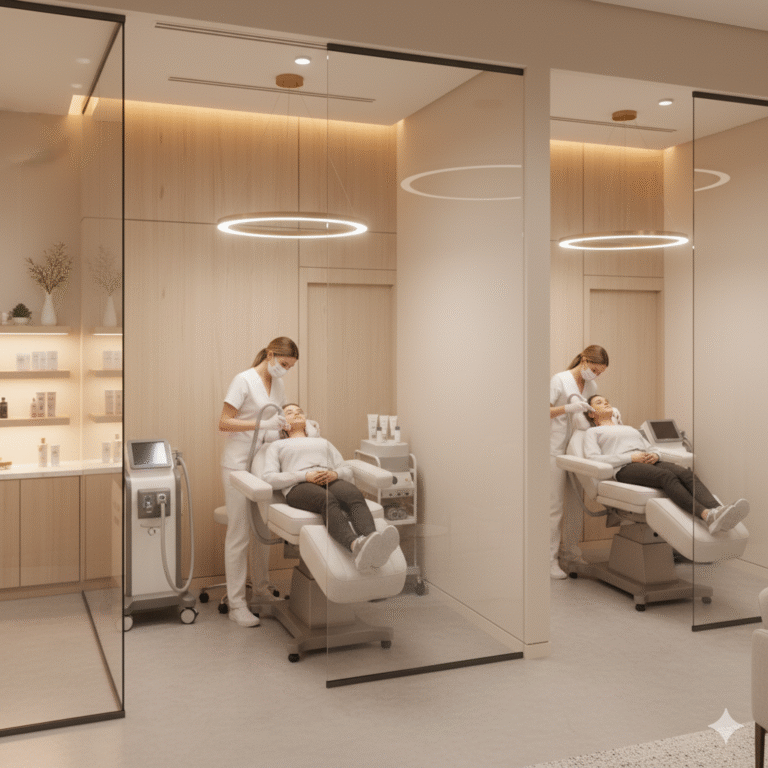The Human Cornerstone of Your Medspa’s Success
If you’ve ever found yourself staring at a scheduling grid with more empty slots than filled ones, or felt that sinking feeling when a star injector gives their notice, you understand a fundamental truth of the medspa business: your team isn’t just a part of your success—it is your success. The treatments you offer are delivered by people, the client experience is crafted by people, and the reputation you build is a direct reflection of your people.
Yet, the medspa industry faces a significant challenge. The U.S. Bureau of Labor Statistics projects a faster-than-average growth rate for healthcare support occupations, intensifying the competition for top talent. Simultaneously, a study published in the Journal of the American Medical Association (JAMA) highlights that burnout among healthcare professionals is linked to a 2x increased risk of patient safety incidents and higher turnover intentions. In a medspa, this translates to inconsistent results, unhappy clients, and a relentless, costly recruitment cycle.
Building a high-performance team that thrives rather than just survives isn’t a soft skill—it’s a hard business strategy. It’s the most effective way to protect your revenue, your reputation, and your own sanity. This guide moves beyond platitudes to provide a practical, science-backed framework for creating a team that is both highly skilled and deeply committed.
Part 1: The Foundation – Strategic Hiring for Long-Term Fit
The most effective way to prevent turnover is to never make a bad hire in the first place. This requires a shift from reactive, desperate hiring to a strategic, discerning process.
1.1 Define the Role Beyond the Technical Skills
A job description that only lists “RN license” and “2 years injecting experience” will attract applicants who can do the job. You need to find people who will thrive in the role.
- Actionable Step: Create a “Success Profile” for each position. For an injector, this might include:
- Technical Skills: IV certification, experience with specific neuromodulators/fillers.
- Soft Skills: Exceptional bedside manner, active listening, ability to educate and manage client expectations.
- Cultural Skills: Collaborative spirit, growth mindset, alignment with the clinic’s core values (e.g., authenticity over aggressive sales).
1.2 Implement a Multi-Stage Interview Process
A single interview is a recipe for mis-hires. A structured process reveals different facets of a candidate.
- Stage 1: The Screening Call. A 15-minute call to confirm basic qualifications, salary expectations, and availability. This efficiently filters out clearly mismatched candidates.
- Stage 2: The Technical & Behavioral Interview. This is the core of the process. Use a consistent set of questions for all candidates for the same role to ensure fairness.
- Technical Questions: “Walk me through your anatomical approach to treating marionette lines.”
- Behavioral Questions (based on the STAR method): “Tell me about a time a client was unhappy with a treatment result. What was the Situation, what Task did you undertake, what Action did you specifically take, and what was the Result?” This reveals problem-solving skills and emotional intelligence.
- Stage 3: The Practical Assessment. For clinical roles, a hands-on assessment is non-negotiable. Have a top-performing team member act as a model for the candidate to perform a consultation (not an actual injection on a new candidate). This assesses their communication, technique, and process.
- Stage 4: The Culture Interview. Have the candidate meet with 2-3 other team members, perhaps over coffee. Do they connect? Do they ask thoughtful questions? Your team’s feedback is invaluable.
1.3 Onboard Like You Mean It
A structured onboarding process can improve new hire retention by 82% (according to a Brandon Hall Group study). The first day should not consist of a mountain of HR paperwork and being thrown onto the floor.
- Actionable Step: Develop a 90-day onboarding plan.
- Week 1: Focus on culture, systems, and observation. Introduce them to everyone, review the employee handbook together, have them shadow top performers.
- Weeks 2-4: Gradual increase in responsibility. Begin with consultations, then treatments under supervision.
- Months 2-3: Regular check-ins (weekly, then bi-weekly) to address questions, provide feedback, and ensure integration.
Part 2: The Framework – Cultivating a Culture of Growth and Respect
A high salary might attract someone, but it won’t keep them if the culture is toxic. Performance is sustainable only in an environment that supports it.
2.1 Foster Psychological Safety
A concept pioneered by Harvard researcher Amy Edmondson, psychological safety is the shared belief that the team is safe for interpersonal risk-taking. It means a nurse feels comfortable speaking up if they see a potential issue, or an esthetician can suggest a new product without fear of being belittled.
- Actionable Steps:
- Leaders Model Vulnerability: Admit your own mistakes. Say, “I tried a new marketing tactic last week that didn’t work as I’d hoped. Here’s what I learned.”
- Frame Work as a Learning Process: Instead of asking “Who’s to blame?” ask “What can we learn from this?”
- Actively Solicit Opinions: In meetings, go around the room and ask each person for their input, especially the quietest members.
2.2 Invest in Continuous, Meaningful Development
Burnout is often less about being overworked and more about being under-challenged or feeling stagnant. A study in the Journal of Occupational and Organizational Psychology found that access to training and development opportunities is strongly linked to job satisfaction and reduced turnover.
- Actionable Steps:
- Create Individual Development Plans (IDPs): Sit with each team member annually and map out their goals. Do they want to learn a new laser? Master a specific injection technique? Develop leadership skills? Create a concrete plan to get them there.
- Lunch & Learns: Have a vendor representative or a senior team member lead a training session on a new product or technique.
- Budget for Conferences: Even if it’s just one key conference a year, sending a team member shows investment and brings new energy and ideas back to the practice.
2.3 Compensate Fairly and Transparently
Compensation is a sign of respect. Ambiguity around pay and bonuses creates resentment and anxiety.
- Actionable Steps:
- Research Market Rates: Use resources like the MGMA (Medical Group Management Association) data or industry-specific surveys to ensure your base salaries and commission structures are competitive.
- Create a Clear, Written Compensation Plan: Every team member should understand exactly how their bonus is calculated—what metrics are used, how often it’s paid out, and what they can do to influence it.
- Consider Non-Monetary Rewards: Additional paid time off, a subscription to a meditation app, or a stipend for continuing education can be highly valued perks.
Part 3: The Fuel – Preventing Burnout Through Sustainable Systems
Burnout is a state of emotional, physical, and mental exhaustion caused by excessive and prolonged stress. It’s not a personal failing; it’s a systems failure.
3.1 Audit Workloads and Schedules Realistically
Packing a provider’s schedule back-to-back with no breaks is a short-term revenue win and a long-term disaster.
- Actionable Steps:
- Build Buffer Time: Mandate 15-minute buffers between appointments. This allows for charting, a bathroom break, and handling unexpected client concerns without causing a cascading delay. This simple change dramatically reduces daily stress.
- Protect Admin Time: Schedule blocks of non-client time for each provider for follow-up calls, continuing education, and team meetings. This work is valuable and deserves dedicated time.
- Rotate Undesirable Tasks: If someone always closes or always handles the most difficult clients, resentment builds. Create a fair rotation system.
3.2 Measure and Act on Engagement
Don’t guess how your team is feeling—ask them. But how you ask is critical.
- Actionable Step: Conduct anonymous pulse surveys quarterly. Keep them short (5-7 questions) and focus on one or two areas, like “Work-Life Balance” or “Resources and Support.” The key is to SHARE THE RESULTS and, more importantly, CREATE AN ACTION PLAN based on the feedback. If you ask for input and ignore it, you destroy trust.
3.3 Lead with Empathy and Clarity
Your team looks to you to set the tone. Your energy is contagious.
- Actionable Steps:
- Practice Active Listening: In one-on-ones, put your phone away and listen to understand, not just to reply.
- Be Clear About Expectations: Ambiguity is a major source of stress. Clearly define roles, responsibilities, and what success looks like for each position.
- Encourage Time Off: And truly mean it. Don’t text employees while they are on vacation. Model this behavior by taking your own time off to recharge.
The Flywheel of Sustainable Performance
Building a high-performance, low-turnover team isn’t a single project you complete. It’s an ongoing operational discipline. It starts with a strategic hire who is a great fit, whom you then nurture through a culture of psychological safety and continuous growth, and protect from burnout with sustainable systems.
Each element reinforces the other. A great hire thrives in a great culture. A supported employee is less likely to burn out. A team that isn’t burning out delivers exceptional, consistent client experiences, which drives revenue and makes it easier to attract more great hires.
The return on this investment is immeasurable. It’s the peace of mind that comes from a self-sustaining team. It’s the financial stability of low recruitment costs and consistent service delivery. It’s the joy of building a practice that is not only profitable but also a genuinely wonderful place to work and receive care. That is the ultimate performance indicator.


